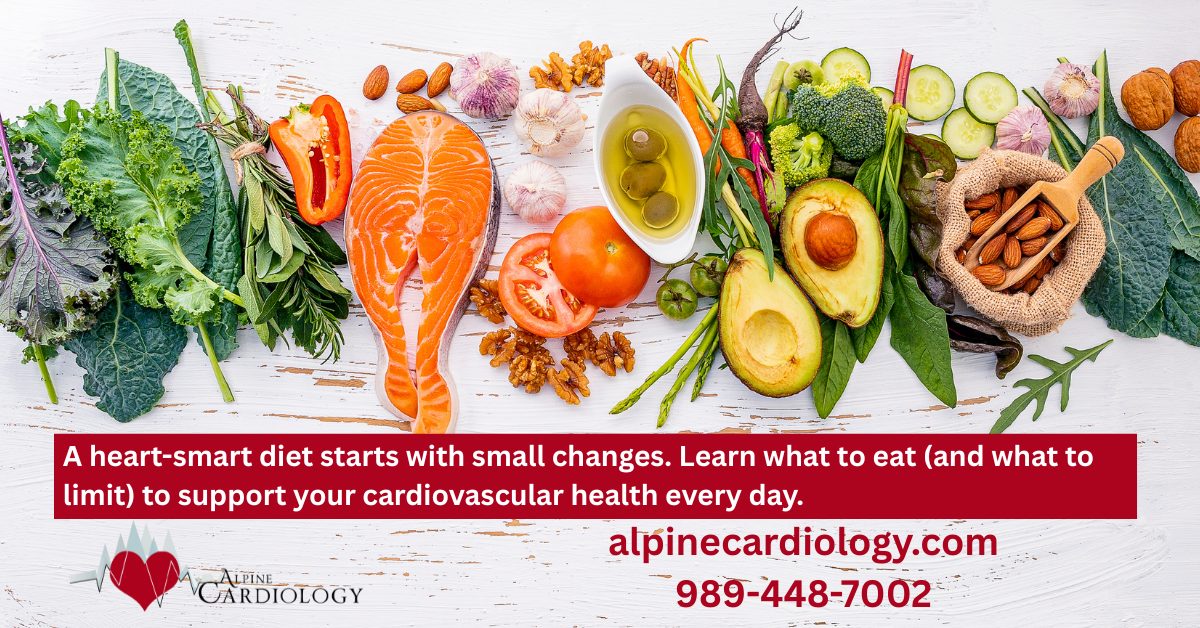A Simple Guide to Heart-Healthy Eating
Eating well doesn’t have to be complicated. The American Heart Association recommends a balanced diet focused on whole, nutrient-rich foods to help protect your heart. Making even small adjustments to what you eat can lower blood pressure, improve cholesterol, and reduce the risk of heart disease.
Here’s a breakdown of what your plate should look like—and how to build a diet that supports a stronger, healthier heart.
🥦 Vegetables: Color Your Plate
- One serving = 1 cup raw leafy greens, ½ cup chopped vegetables, or ½ cup vegetable juice.
- Choose deeply colored vegetables like spinach, carrots, broccoli, and bell peppers.
- Pick fresh, frozen, or canned (with no added salt or fat) to make veggies easy and convenient.
🍓 Fruits: Sweet and Heart-Smart
- One serving = 1 medium fruit, ½ cup fresh/frozen/canned fruit, or ¼ cup dried fruit.
- Prioritize fiber-rich fruits such as berries, apples, oranges, and peaches.
- Eat whole fruits when possible—juice often lacks the fiber and fullness whole fruits provide.
🌾 Whole Grains: Go for the Good Stuff
- One serving = 1 slice of bread, ½ cup cooked cereal/pasta/rice, or 1 cup flaked cereal.
- Make at least half of your grains whole: think brown rice, oats, whole-grain pasta, and 100% whole-wheat bread.
- Aim for 25–30 grams of fiber from food daily—not supplements.
🍗 Lean Proteins: Keep It Light
- Less than 6 oz. per day of cooked lean meat, poultry, or fish.
- A portion = about the size of a deck of cards or ½ a chicken breast.
- Eat baked or grilled fish (like salmon, trout, or herring) at least twice a week.
- Remove skin from poultry and trim visible fat from meats before cooking.
🥜 Nuts, Seeds & Legumes: Plant Power
- One serving = ½ cup cooked beans, 2 Tbsp. peanut butter, 1½ oz nuts, or ½ oz seeds.
- Beans are great in soups, salads, and pasta dishes.
- Choose unsalted nuts and use them in stir-fries, cereals, or yogurt for extra crunch.
🥛 Low-Fat Dairy: Keep It Lean
- One serving = 1 cup milk/yogurt or 1½ oz low-fat cheese (about 6 stacked dice).
- Stick to 0%–1% milk and fat-free or low-fat yogurt with no added sugar.
- Choose cheeses with less than 3g of fat and 2g of saturated fat per oz.
💡 Ask Your Cardiologist:
Bringing questions to your next appointment helps you stay on track. Here are a few to consider:
- How many calories should I eat each day?
- What’s a good, heart-healthy cookbook you recommend?
- What changes will have the biggest impact on my heart health?
Write your questions down—you’re more likely to remember them and get the answers that matter.
Your heart is in your hands. Making smart food choices now leads to better health later. Start with one small change this week and build from there.
Dr. Bobish
Dr. Bobish and her team’s goal is to help you reduce your risk of heart disease. Helping you to understand your risk factors and make healthful lifestyle changes.
Remember regardless of age or current state of health it is never too late to start protecting your heart. It is also never too soon and the sooner you act the better. Follow us on Facebook to see our latest post helping to keep you heart healthy. You can also explore all our articles that offer diet and exercise tips, recipes and information on procedures and heart disease.
Dr. Bobish and her team focus on preventative care and are here to support you. Alpine Cardiology provides patients with education as well as compassionate care and treatment. We are committed to keeping you healthy and heart smart! Request an appointment at 989-448-7002

